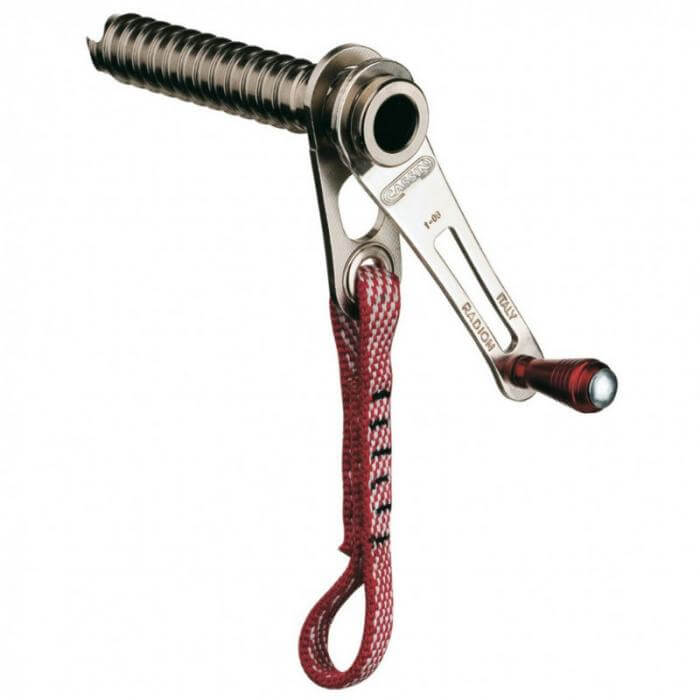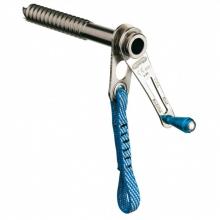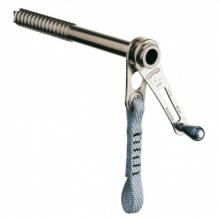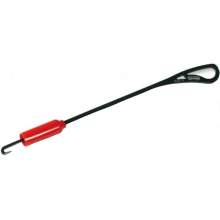Radion 12cm
Description
Can be clipped to the rope while placing to prevent accidental loss.
Machined with a shaft thickness tolerance of only 0.03 mm.
Front teeth are milled with three different angles for fastest penetration.
Reverse angle threads are optimized for brittle ice.
Angled lever arm provides clearance during placement.
Reduces total rack weight with the built-in sling.
Bright finish on hanger and lever helps reduce melt out in the sun.
Easy racking with two clipping points.
Includes tip protector and thread guard for packing.
The Radion is the most advanced ice screw available. A unique hanger rotates independently on the shaft, ensuring the force of a fall is applied at the optimal angle. The Radion features a reverse angle on the threads (flat side towards the ice), to distribute pressure more uniformly in brittle ice. Placing a Radion is greatly simplified by the aggressive front teeth, an ultra-smooth shaft, and a stiff lever arm with a rotating knob. The color-coded Dyneema sling saves the weight and hassle of an extra draw. With a carabiner pre-attached you can be moving upwards faster than ever. The screw can be placed or removed while clipped to the rope ensuring it will never get dropped. A carabiner hole on the steel hanger gives a second option for racking.
Can be clipped to the rope while placing to prevent accidental loss.
Machined with a shaft thickness tolerance of only 0.03 mm.
Front teeth are milled with three different angles for fastest penetration.
Reverse angle threads are optimized for brittle ice.
Angled lever arm provides clearance during placement.
Reduces total rack weight with the built-in sling.
Bright finish on hanger and lever helps reduce melt out in the sun.
Easy racking with...
read moreRetail price
This Product is Hard to Find.
We don’t know where you can buy this item online in the US. We’ll continue to check all the major retailers and will update this page as soon as we find one.
If you know where to find this online in the US, let us know, and we’ll add the link.
Weight (grams / ounces)  | 155 g / 5.50 oz |
Length (cm)  |
12 cm |
Feature(s)  |
Handle (non-fold) Color Coding Sewn Sling Attached 2 Clip Points Reverse Threading |
Strength (kn)  |
|
Materials  | Hanger: Chromoly Steel Tube: Chromoly Steel Teeth: Chromoly Steel |
Certification  |
|
No reviews yet.
One of the positive features of this design though was the fact that it can be clipped to the rope before it is wound in (or out), meaning that the screw won't be dropped. In use we found clipping screws to the rope before placing them to be impractical, but taking them out whilst they are still clipped to the rope (whilst you are seconding) did actually work a treat. So no dropped screws by your second anymore!
Summary: Decent screws with an interesting double unit on the head. Quite heavy for the size, but could be used just with a carabiner instead of a quickdraw, although we preferred not to. Awkward to clip. Interesting reverse thread design could increase holding power in brittle ice.
Because of these drawbacks and its high price, I would categorize the Radion as a go-to niche screw. Though Radions will never become the backbone of my rack, I also will never leave the ground without a few on an extra cold day.
Pros: Sharp teeth bite well in cold ice; solid, low-profile arm offers great crank leverage; unique thread design fractures less ice; floating hanger allows leader to clip into a partially placed screw.
Cons: Long crank arm gets caught up on textured ice; awkward racking; expensive.




